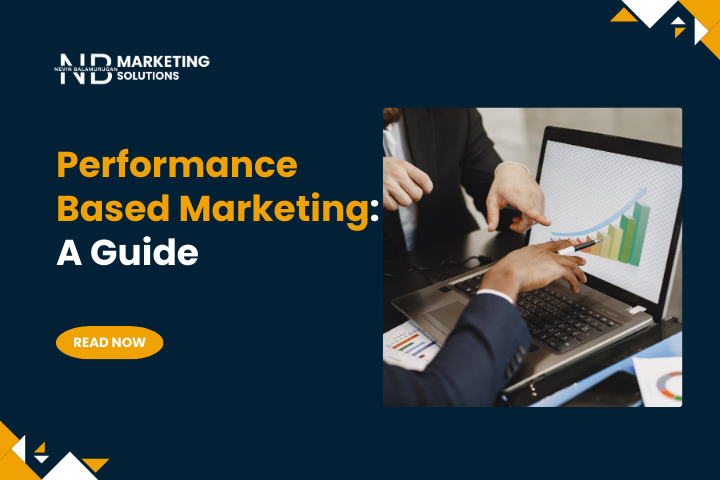Performance-Based Marketing in 2025 | A Complete Guide
Abirami Dharmalingam
September 15, 2025

Use Performance-Based Marketing to Generate Only Leads
Have you ever wondered why so many businesses use performance-based marketing? Today, companies want every dollar to prove its worth. According to a report, 83% of global marketing leaders indicate that their top priority is return-on-investment (ROI).
Consider this – would you rather invest in vague brand awareness or in actual clicks, leads, and sales? Most of you will choose the second option, that’s what performance marketing is – you only pay when a specific action occurs.
Without delay, let’s get a deep dive into it. Here, you’ll know what performance marketing is, how it works, pros and cons, channels you can use, and KPIs you need to check.

What is Performance-Based Marketing?
Performance-based marketing is a type of marketing that enables advertisers to pay only for specific actions, such as filling out a form, purchasing, or downloading.
How does Performance-Based Marketing Work?
Unlike traditional advertising, where you pay for exposure, performance marketing ensures that you only spend when your goals are met.
Here’s a closer look at how it works:
- Advertiser sets the goals: It can be traffic, leads, sales, or downloads. They set budgets and choose the metrics they’ll pay for (like clicks, conversions, or purchases).
- Publishers promote the offer: They promote the product or service across platforms to drive high-quality traffic that matches the advertiser’s target audience.
- Tracking network: It is a third-party network where advertisers and publishers connect and track performance.
- They track real-time performance: They can see exactly how campaigns are performing – what’s working, what’s not, and where to optimize.
- Assign payment after results: When a specific action occurs, advertisers pay for it – which advertisers can reduce risk and guarantee ROI.
Pros and Cons of Performance Marketing
But like other marketing strategies, this also comes with both benefits and limitations. Let’s look at both before starting out your marketing campaign in performance-based marketing.
Pros of Performance Marketing
- You get a higher chance of results: When someone’s income depends on the outcomes they deliver, they will dive deeper to test, optimize, and work a lot to hit your goals.
- You get higher ROI: With performance marketing, you’ll pay for your goals like clicks, leads, or sales. That makes it easier to justify your spend and double down on what works.
- You get better customer insights: Your data shows exactly who your best customers are, where they come from, and what content resonates with them.
- You have low financial risk: With performance marketing, you pay only for specific actions so your budget is protected from underperforming campaigns that drain your dollars.
- You can target smartly: You can fine-tune your targeting so your customers can see your compelling ads at the right moment.
Cons of Performance Marketing
- It can take some time on revenue metrics: Good marketing doesn’t work instantly. It takes time to test, learn, and optimize for every meaningful click. So, you can’t expect KPIs results like ROAS (Return on Ad Spend) or LTV (Lifetime Value) overnight.
- It doesn’t apply to every advertiser: Some agencies don’t offer performance-based pricing. Because they can’t deliver results due to a specific niche, audience, or sales cycle. It is too complex to guarantee outcomes for specific niches.
- It can’t measure your impact: No visible impression doesn’t mean no impact on your marketing strategy. For some niche or target audience, it takes some time to build awareness, trust, and buy from you.

Top Performance-Based Marketing Channels
Performance marketing covers a wide range of marketing channels where each acts to reach, connect, and convert your target audience. Let’s break down the key performance marketing channels and how they work.
Search Engine Marketing (SEM): This is the practice where advertisers pay to have their ads placed above organic results in search engine results for relevant business terms. You pay only when the customer clicks on your ad, making it a highly measurable channel for capturing high-intent traffic.
Social Media Marketing: Your ads target only customers or prospects who have visited your website by showing interest in your product or service. You can also promote your brand across social media platforms like Instagram, TikTok, Facebook, and LinkedIn with the help of creators and influencers.
Display Advertising: You can display your ads on web pages in the form of banner ads. These ads show up on popular websites, news sites, and across the Google Display Network.
Native Advertising: Native ads blend seamlessly with the platform they appear on. They often feel like part of the content rather than a traditional ad, and advertisers pay partners based on conversions.
Affiliate Marketing: In affiliate marketing, a partner promotes your product or service using a unique link or code. So that they can earn a commission whenever their audience completes a specific action, like a purchase or sign-up.
Influencer Marketing: You can collaborate with influencers and content creators to reach their engaged audiences. Influencers authentically promote your offer and inspire their followers to take action.
Performance Marketing KPIs You Need to Watch
Don’t know how to measure your performance marketing campaign? No worries, all you need to look at the KPIs. Key performance indicators (KPIs) are tools that can help you determine how your marketing campaign is working. You can easily measure your performance by choosing the KPI you need.
Moreover, these performance advertising metrics determine how and when your partners get paid. Now let’s break down the most common performance marketing metrics:
- Cost Per Click (CPC) / Pay Per Click: It is all about paying for clicks. You’d pay each time your partner drives your customer to click – that’s why tracking URLs and UTMs are critical, so you can distinguish between regular customers and customers influenced by your partners.
- Cost Per Acquisition (CPA) / Pay Per Sale: If sale is your priority, CPA is best. You pay your partner only when a customer makes a purchase directly tied to their link, code, or ad.
- Cost Per Lead (CPL) / Pay Per Lead: If leads are your priority (like email signups or demo requests), CPL is best. You pay partners when a customer shares their information through a form or sign-up. By this, you can convert these leads into paying customers.
- Cost Per Impression (CPM) / Cost Per Mile: This KPI lets you pay based on the number of impressions your ad gets. CPM pays out per 1,000 impressions.
- Return on Ad Spend (ROAS): This metric measures how much revenue your ads generate for every dollar spent.
Reach Our Experts Now for Your Performance-Based Marketing Campaign
Performance marketing is the best option if you don’t want to waste your dollar. Moreover, executing with a plan, strategy, the right tools, the right partner, and optimization matters here. Without perfect planning, you can lose all your time and money without a deal.
If you’re looking for experts who perform performance-based marketing effectively, NB Marketing Solutions can help you. Our team of experts specializes in creating performance advertising strategies that deliver measurable results for businesses of all sizes.
So don’t just run campaigns – run campaigns that perform well. Partner with NB Marketing Solutions and maximize your ROI.
FAQs
1. What is performance marketing?
Performance marketing is a digital marketing strategy where you pay only when specific actions are completed.
2. How does performance marketing work?
It works through partnerships with affiliates, influencers, or publishers. Each partner promotes your product or service using unique tracking links or codes. You only pay when the specific action is completed.
3. Which channels are best for performance marketing?
You can use channels such as paid search (SEM), paid social media, email partnerships, native advertising, display advertising, affiliate marketing, and influencer marketing.
4. How do you measure performance marketing?
You can measure through metrics like CPA for sales, CPC for traffic, CPL for lead generation, and CPM for awareness.
5. Is performance marketing suitable for all businesses?
Yes, but it works best for businesses that want measurable outcomes and ROI from their marketing spend.
Recent Posts
Have Any Question?
- (+91) 938-542-1049
- info@nbmarketingsolutions.in
Categories
Make Appointment
Confused Over Choosing The Right Services For Your Business?
Tamil Nadu, India
- Near TMB Bank, Anjugramam post, Kanyakumari 629401
- info@nbmarketingsolutions.in
- (+91)93-8542-1049
